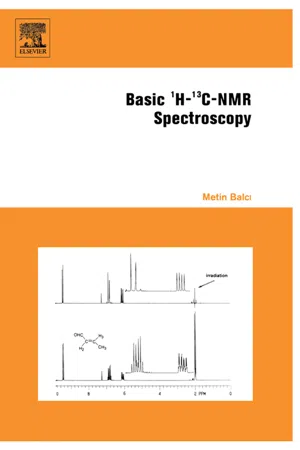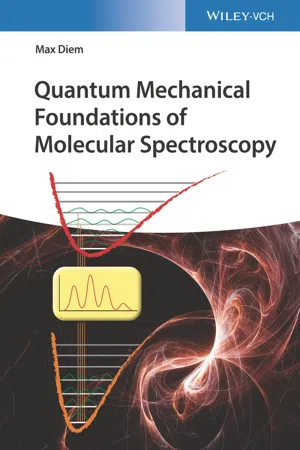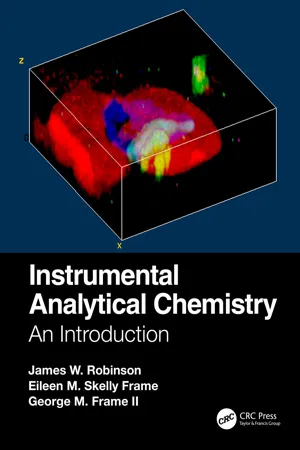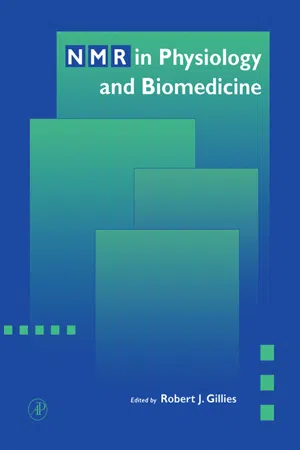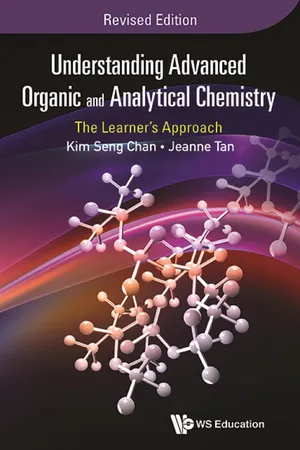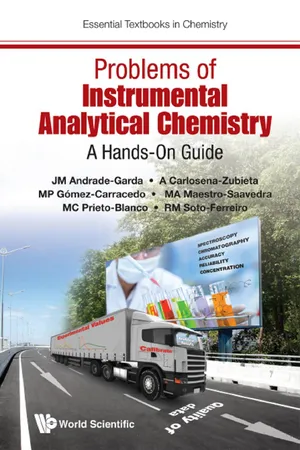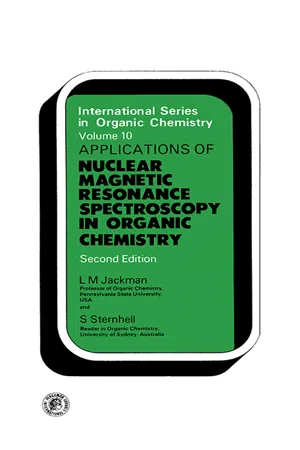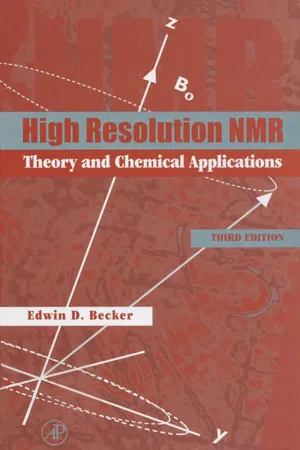Chemistry
Nuclear Spin Resonance
Nuclear spin resonance is a phenomenon in which atomic nuclei absorb and re-emit electromagnetic radiation at specific frequencies when placed in a magnetic field. This technique is widely used in chemistry to study the structure and dynamics of molecules, as well as to determine the chemical environment of atoms within a molecule. Nuclear spin resonance is the basis for nuclear magnetic resonance (NMR) spectroscopy.
Written by Perlego with AI-assistance
Related key terms
Related key terms
1 of 4
Related key terms
1 of 3
12 Key excerpts on "Nuclear Spin Resonance"
- eBook - ePub
- Metin Balci(Author)
- 2005(Publication Date)
- Elsevier Science(Publisher)
2Resonance Phenomena
Publisher Summary
This chapter explains the resonance phenomena and begins with a discussion of NMR spectroscopy based on magnetic properties of atomic nuclei. Atoms consist of a dense, positively charged nucleus surrounded at a relatively large distance by negatively charged electrons. The relation between the angular momentum and the magnetic moment is explained in detail. The behavior of magnetic dipole (of any kind of element) is discussed under the section spin quantum numbers of elements. The gyrometric ratios of some nuclei are shown in a table and the spin quantum numbers and the natural abundance (%) of some useful nuclei are given for the reader. Equations are presented and explained to understand the behavior of an atomic nucleus in a magnetic field. The various processes that tend to restore the original equilibrium condition among the energy levels known as the relaxation phenomena are explained with the help of a diagram. The different instruments and the types of NMR spectrometer based on different designs are explained with diagrams.2.1 MAGNETIC PROPERTIES OF ATOMIC NUCLEI
Nuclear magnetic resonance spectroscopy is based on the magnetic properties of atomic nuclei. Let us first discuss the magnetism of atomic nuclei. Atoms consist of a dense, positively charged nucleus surrounded at a relatively large distance by negatively charged electrons. At this stage we will ignore the electrons and concentrate on the nucleus. We can consider it to be a spherical spinning object with all of its charge spread uniformly over its surface. This model is, of course, considerably oversimplified. Since atomic nuclei are positively charged, they can also be thought of as being much like tiny magnets. In some nuclei, this charge spins on the nuclear axis. The circulation of nuclear charge generates a magnetic dipole along the axis of rotation (Figure 2 - Max Diem(Author)
- 2021(Publication Date)
- Wiley-VCH(Publisher)
Eq. (8.9) are indistinguishable (degenerate). However, if an electron is placed in a magnetic field – either an externally applied magnetic field or the magnetic field of another electron or nucleus – the energy states of the spin momentum split into “parallel” and “antiparallel” spin states. When exposed to electromagnetic radiation of the appropriate energy, transitions between these spin states may occur. This gives rise to a spectroscopic technique referred to as “electron paramagnetic resonance,” also sometimes known as “electron spin resonance” (ESR). EPR signals can only be observed for molecular or atomic systems that have unpaired electronic spin, that is, for “radical” atomic or molecular systems. Although EPR is a mature and very useful technique, many of its principles are transferable from proton magnetic resonance spectroscopy, and it will not be covered here in favor of “nuclear” magnetic resonance spectroscopy, which is one of the most widely applied spectroscopic methods in chemical research.8.3 Nuclear Spin
What was elaborated upon in Eqs. (8.3) –(8.10) for electrons holds equally well for any nucleus that has a nuclear spin quantum number , such as 1 H and 13 C. The concept of nuclear spins arises from the fact that nucleons themselves have an – albeit much smaller – intrinsic spin moment. In atomic nuclei that have even numbers of protons and neutrons, the spin moment is zero. Examples for such nuclei are 12 C and 16- eBook - ePub
- Rui Yang(Author)
- 2018(Publication Date)
- CRC Press(Publisher)
5 Nuclear Magnetic Resonance SpectroscopyIn an external magnetic field, the nucleus of an atom may exist in various spin states; thus, it can have different energies. When this nucleus is irradiated with the electromagnetic waves of an appropriate frequency, it absorbs the energy and jumps from the ground state to the excited state, producing a nuclear magnetic resonance (NMR) signal. Similar to ultraviolet–visible (UV–Vis) and infrared (IR) spectroscopy, NMR spectroscopy is also a type of absorption spectroscopy. The only difference is that in NMR spectroscopy, nuclei absorb radiofrequency (RF) energy and exhibit spin transitions; in UV–Vis spectroscopy, electrons absorb UV–Vis light and exhibit electronic transitions; while in infrared (IR) spectroscopy, molecules absorb IR light and exhibit vibrational and rotational transitions.
In NMR spectroscopy, nuclei with nonzero magnetic moments are studied.5.1 Basic Principle of NMR5.1.1 Magnetic Moment of NucleusA spinning nucleus possesses angular momentum P . As the nucleus has a positive charge, a magnetic field with a magnetic moment μ, is produced, because of spinning. The angular momentum and magnetic moment are related to each other as follows:μ = γ P .5.15.1Here, γ is the nuclear magnetogyric ratio , an intrinsic character of a specific nucleus. μ is expressed in units of the nuclear magneton β, where β is a constant (5.05 × 10−27 J/T). Table 5.1 - eBook - ePub
Instrumental Analytical Chemistry
An Introduction
- James W. Robinson, Eileen M. Skelly Frame, George M. Frame II(Authors)
- 2021(Publication Date)
- CRC Press(Publisher)
It is too small to vibrate, rotate, or electronically excite an atom or molecule. It is great enough to affect the nuclear spin of atoms in a molecule. As a result, spinning nuclei of some atoms in a molecule in a magnetic field can absorb RF radiation and change the direction of the spinning axis. In principle, each chemically distinct atom in a molecule will have a different absorption frequency or resonance if its nucleus possesses a magnetic moment. The analytical field that uses absorption of RF radiation by such nuclei in magnetic fields to provide information about a sample is NMR spectroscopy. In analytical chemistry, NMR is a technique that enables us to study the shape and structure of molecules. In particular, it reveals the different chemical environments of the NMR-active nuclei present in a molecule, from which we can ascertain the structure of the molecule. NMR provides information on the spatial orientation of atoms in a molecule. If we already know what types of compounds are present, NMR can provide a means of determining how much of each is in the mixture. It is thus a method for both qualitative and quantitative analysis, particularly of organic compounds. In addition, NMR is used to study chemical equilibria, reaction kinetics, the motion of molecules, and intermolecular interactions. Three Nobel Prizes have been awarded in the field of NMR. The first was in 1952 to the two physicists, E. Purcell and F. Bloch, who demonstrated the NMR effect in 1946. In 1991, R. Ernst and W. Anderson were awarded the Nobel Prize for developing pulsed FTNMR and 2D NMR methods between 1960 and 1980. FTNMR and 2D experiments form the basis of most NMR experiments run today, even in undergraduate instrumental analysis laboratories. We will use the acronym NMR to mean FTNMR, since this is the predominant type of NMR instrument currently produced - eBook - ePub
- Robert J. Gillies(Author)
- 2013(Publication Date)
- Academic Press(Publisher)
1Introduction to Nuclear Magnetic Resonance
E. Raymond AndrewPublisher Summary
This chapter discusses nuclear magnetic resonance (NMR ). NMR is the branch of spectroscopy operating in the radiofrequency region of an electromagnetic spectrum. It arises from the interaction between atomic nuclei and a magnetic field. Compared with other areas of physics, NMR signals are relatively weak and must be sought and managed with care. However, this relative weakness of NMR enables it to probe materials and living systems without disturbing them and yield detailed information in a noninvasive manner. NMR imaging can be applied to systems of any size, large or small. The most intensive effort has been applied to imaging the human body because of the value of NMR imaging in clinical applications. The advantage of NMR microscopy is that it is nondestructive; it is not necessary to cut and mount sections. The biological development of the object studied can be followed continuously without damage.I INTRODUCTION
Nuclear magnetic resonance (NMR) is a remarkably versatile phenomenon. Discovered in 1946 (Bloch, Hansen, and Packard, 1946 , Purcell, Torrey, and Pound, 1946 ) it was initially important in physics but soon also became an essential analytical and structural technique in chemistry. It swept across the disciplines to biochemistry and physiology and on to medicine where it is now firmly established as a standard modality of diagnostic investigation and research. There have been applications in fields as diverse as archeology, oil prospecting, and veterinary science; few areas of scientific endeavor remain untouched by NMR. In this chapter we provide an introduction to NMR, in the context of physiology and medicine, particularly for those readers with little previous acquaintance with the subject. For further discussion of basic principles of NMR the reader is referred to Harris (1983) , Slichter (1990) , Abragam (1961) , and Ernst, Bodenhausen, and Wokaun (1987) - eBook - ePub
- Frank A. Bovey, Peter A. Mirau(Authors)
- 1996(Publication Date)
- Academic Press(Publisher)
1FUNDAMENTALS OF NUCLEAR MAGNETIC RESONANCE
1.1 INTRODUCTION
NMR spectroscopy is a method of great interest and importance for the observation of every aspect of the structure and properties of macromolecular substances. The first studies were reported by Alpert (1 ) only about a year after the discovery of nuclear resonance in bulk matter (2 ,3 ). It was observed that natural rubber at room temperature gives a proton linewidth more like that of a mobile liquid than of a solid, but that the resonance broadens markedly at temperatures approaching that (ca. −70°C) now known as the glass temperature. These phenomena were recognized as being related to the presence (and cessation) of micro-Brownian motion. We shall relate these matters in more detail when we deal with the vital topic of polymer NMR in the solid state. For the present we note that this field was well developed before high-resolution spectra of synthetic polymers in solution were first reported by Saunder and Wishnia (4 ), Odajima (5 ), and Bovey et al. (6 ). From today’s perspective it is difficult to understand why the observation of such spectra was so long delayed, especially since the NMR spectroscopy of small molecules was in an advanced state. It appears that solution spectra were generally expected to be very complex and to exhibit resonances too broad to be usefully interpreted. As we shall see, such fears were in general not well founded. Modern instrumental methods have made it possible to obtain dynamic information from polymer solutions as well as solids and to obtain structural information from solid polymers as well as solutions. Thus, the barrier between two once quite separate modes of study of macromolecules—solid- and liquid-state NMR spectroscopy—has all but disappeared.1.2 NUCLEAR SPIN AND THE NMR PHENOMENON
In addition to charge and mass, which all nuclei have, many isotopes possess spin, or angular momentum. Since a spinning charge generates a magnetic field, there is a magnetic moment associated with this angular momentum. The magnetic properties of nuclei were first postulated by Pauli (7 - eBook - ePub
- Carlos Rodrigues da Cruz, João L. Figueirinhas, Pedro J. Sebastião(Authors)
- 2016(Publication Date)
- Jenny Stanford Publishing(Publisher)
Chapter 4Fundamentals of Nuclear Magnetic Resonance
4.1Introduction
Nuclear magnetic resonance (NMR) is a powerful analytical technique with application in materials science, biology, and medicine. Nowadays NMR is an essential tool for the synthetic chemist as well as the materials scientist, but it has made the connection with the great public through imagiology where magnetic resonance imaging (MRI) constitutes one of the most important methods of in vivo observation of structure and functionality of a living body. Foreseeing its great potential, the discovery and developments of this technique were recognized as major scientific achievements and have been rewarded with the attribution of several Nobel Prizes to those responsible for the discovery and development of the technique. It all started with the discovery of NMR in 1936 by Isidor Rabi while studying molecular beams (Rabi, 1937). Rabi found that a molecular beam exposed to a static magnetic field and submitted to radio waves can experience changes in the nuclear spins direction in a quantized form following quantum mechanics rules. For this discovery Rabi was awarded the Nobel Prize in Physics in 1944. The extension of this technique to the study of liquids and solids by Felix Bloch and Edward M. Purcell in 1944 when they were trying to measure nuclear magnetic moments with higher precision using liquids and solids (Bloch, 1946; Purcell, 1946) granted them also the Nobel Prize in Physics that they shared in 1952. The first commercially available NMR spectrometer appeared in 1953 and since then a huge development of this technique took place. By 1970 pulsed methods were introduced in NMR and rapidly replaced the continuous-wave (CW) excitation (CW NMR) used up to then. The pulsed method, allied to the use of computer-implemented fast Fourier techniques, allowed the study of much more diluted samples and also much less abundant nuclear species. These pulsed techniques opened the way to what is called today 2D NMR where complex sequences of radio-frequency (RF) pulses generating 2D spectra are used. Richard R. Ernst, a prominent researcher in this area, was awarded the Nobel Prize in Chemistry “for his contributions to the development of the methodology of high-resolution nuclear magnetic resonance” in 1991 (Ernst, 1976). Since then, multidimensional NMR has grown continuously and in 2002 Kurt Wuthrich shared the Nobel Prize in Chemistry “for his development of nuclear magnetic resonance spectroscopy for determining the 3D structure of biological macromolecules in solution” (Wuthrich, 1983). As pointed before one very important development of the NMR technology that has reached the great public is MRI, an imaging technique with unique capabilities in the fields of anatomy and physiology, the relevance of this technique has been recognized and two leading researchers were distinguished in 2003, Paul C. Lauterbur and Sir Peter Mansfield were awarded the Nobel Prize in Physiology or Medicine “for their discoveries concerning magnetic resonance imaging.” - eBook - ePub
Understanding Advanced Organic and Analytical Chemistry
The Learner's ApproachRevised Edition
- Kim Seng Chan, Jeanne Tan;;;(Authors)
- 2016(Publication Date)
- WS EDUCATION(Publisher)
CHAPTER 17 Nuclear Magnetic Resonance Spectroscopy 17.1 Introduction Previously, in the chapter on IR spectroscopy, we talked about the three ways to describe the movement of a molecule in space, namely translational, rotational and vibrational motion. The rotational motion about an axis is analogous to the spinning motion of a top. Other than for molecule, such spinning motion (or spin, for short) is also an intrinsic property of particles such as electrons, protons and neutrons. Similar to any linear translation, we can ascribe a magnitude and direction to the spin of a particle. This would mean that we can describe a particle’s spin in terms of how fast it rotates about a particular axis. The direction of the rotation about this axis can be crudely perceived as being clockwise or anti-clockwise. You may have come across the following orbital-as-box diagram, which depicts orbitals as boxes. These are occupied by electrons, with the spins denoted by half-headed arrows as follows: The up and down directions of the arrows denote the two nondegenerate spin states of an electron. Metaphorically, it spins either in a clockwise direction or in an anticlockwise direction. An electron is said to be a spin-1/2 particle. Other spin-1/2 particles include the proton. Both the electron and proton are charged particles that generate a magnetic field when they spin about their own axis. If both the electron and proton spin in the same direction, the magnetic field generated would be in opposite directions. Q: What is a magnetic field? A: A magnetic field is a force field that is generated when a charge particle moves, either in a translational or rotational manner. When a charge particle is stationery, it has a static electric field surrounding it. As it moves along a path, there is a “track” of the changing electric field - eBook - ePub
Problems of Instrumental Analytical Chemistry
A Hands-On Guide
- JM Andrade-Garda, A Carlosena-Zubieta;MP Gómez-Carracedo;MA Maestro-Saavedra;MC Prieto-BlancoRM Soto-Ferreiro(Authors)
- 2017(Publication Date)
- WSPC (EUROPE)(Publisher)
CHAPTER 7
NUCLEAR MAGNETIC RESONANCE AND MASS SPECTROMETRIES
Miguel Angel Maestro-Saavedra
OBJECTIVES AND SCOPE
The main objective of this chapter is to present students a concise, basic and practical overview of two powerful techniques for the structural characterization of organic and inorganic chemical structures; namely, nuclear magnetic resonance (NMR) spectrometry and mass spectrometry (MS). Explanations range from essential background to descriptions of key concepts to some practical applications. A selected collection of exercises show how these key concepts are applied and how a structural elucidation from the NMR and MS spectra can be obtained.To explain how to interpret a mass spectrum is anything but simple because there are no fixed rules which can be followed. Therefore, in this chapter, it is attempted to present the very basics of the MS technique and give some general guidances, along with some examples.PART A: NUCLEAR MAGNETIC RESONANCE SPECTROMETRY
1.INTRODUCTION TO NUCLEAR MAGNETIC RESONANCE
Nuclear magnetic resonance (NMR) spectrometry is a fundamental tool for the structural determination of organic and inorganic molecules. It employs low-energy radiation, in the radio frequencies (RF) region, in order to gather information on the structure of alkyl groups and other hydrogen-containing elements. Then, the presence of functional groups in the molecule is deduced.1.1.Basic principles
Many atomic nuclei behave as if they were spinning around themselves (nuclear spin) . When a charged particle (nucleus) moves or rotates, it creates a magnetic field. The orientation of H is random in the space until the nuclei is inserted in an external magnetic field Ho, which causes H to get aligned with H 0 . This can occur in two forms: aligning the magnetic moment H in the direction of the H 0 field (energetically favorable) or otherwise, counterclockwise to H 0 (it requires the input of energy as it is energetically unfavorable). The two possibilities are referred to as the nuclear spin states α and β - eBook - ePub
Application of Nuclear Magnetic Resonance Spectroscopy in Organic Chemistry
International Series in Organic Chemistry
- L. M. Jackman, S. Sternhell, D. H. R. Barton, W. Doering(Authors)
- 2013(Publication Date)
- Pergamon(Publisher)
Rotation about single bonds results in a situation which is rather similar to chemical exchange, in that signals characteristic of each conformation may or may not be observed depending on the rate of conformational interchange and on considerations of molecular asymmetry. Similarly, the magnitudes of coupling constants can be influenced by chemical and conformational exchange.Time-dependent phenomena are dealt with in Chapter 2-1 .† The neutron has I = and possesses a magnetic moment even though it has no net charge. This apparent paradox is resolved in terms of Yukawa’s dissociation theory in which it is assumed that the neutron, for a fraction of its life-time, is partially dissociated to a proton and negative meson, the magnetic moment of the latter being larger than, and of opposite sign to, that of the former.† The gauss is strictly speaking the unit of magnetic induction and the field strength should be measured in oersteds. In air the two units are almost equivalent and the former is commonly used.‡ We may note that ω0 is independent of the angle θ .† This is correct to at least a very high order of approximation, provided the experimental conditions are chosen to render differences in saturation unimportant.† Which now appears as a doublet of quartets (see insert in Fig. 1-1-10 ).‡ This is only true at room temperature if the concentration of water is comparatively low (< 30 percent v/v).Passage contains an image CHAPTER 1-2
THE EXPERIMENTAL METHOD
Publisher Summary
This chapter discusses the calibration of spectra and the methods of expressing results. From the organic chemist’s point of view, nuclear magnetic resonance (NMR) is principally a spectroscopic method that, like infrared and ultraviolet spectroscopy, provides numbers characteristic of atoms and their arrangements in complex molecules. The chapter focuses on the measurement of absorption intensities as this forms the basis of the use of NMR spectroscopy for quantitative analysis in organic chemistry. The factors that are important in the design of magnets for spectrometers are the constancy of the field strength, the homogeneity or uniformity of the field, and the maximum obtainable strength of the field. A highly constant magnetic field strength is necessary for the accurate determination of relative line positions in a spectrum. Permanent magnets are capable of maintaining fields that are sufficiently constant, provided they are very carefully thermostated and are located in situations that are well away from variable magnetic influences, such as large moving iron objects. - eBook - ePub
Polymer Characterization
Physical Techniques, 2nd Edition
- Dan Campbell, Richard A. Pethrick, Jim R. White(Authors)
- 2017(Publication Date)
- CRC Press(Publisher)
The receiver signal is preamplified and then passed through a phase-sensitive detector and analogue to digital convertor for subsequent processing. The samples are contained in glass tubes (about 5–12 mm diameter) located in an air driven rotating spinner or turbine to even out local field inhomogeneities. The higher the spinning frequency the higher the signal intensity and the smaller the spinning side band signals which are a result of non-uniform spinning of the sample. Rates of up to 200 rpm are used. It is common practice to locate a reference standard in a small capillary tube within the sample tube. For 1 H NMR the reference standard is usually tetramethylsilane, Si(CH 3) 4 The use of variable temperature accessories permit NMR spectra to be recorded over temperature ranges from –150 to +200°C by flowing cooled or heated nitrogen over the sample holders. Modern NMR spectrometers are computer controlled with the operating conditions being preset by the operator. A number of specialized techniques which facilitate the interpretation of NMR spectra will be considered later in this section. 6.3.2 Double Resonance Techniques (a) The Nuclear Overhauser Effect (NOE) Double resonance techniques are particularly useful in enhancing the intensities of spectral lines and in the study of time dependent effects. The enhancement arises due to changes in relaxation behaviour of one nuclear transition as a consequence of the saturation of other nuclear transitions. There is a necessary requirement, therefore, that dipole–dipole coupling be responsible for the relaxation phenomenon. This means that the nuclei in question are located sufficiently close together since the magnitude of dipole–dipole coupling falls off as 1/ r 6 - eBook - ePub
High Resolution NMR
Theory and Chemical Applications
- Edwin D. Becker(Author)
- 1999(Publication Date)
- Academic Press(Publisher)
Chapter 7 , application of this concept is extremely important in obtaining narrow NMR lines in solids. We shall also encounter numerous examples in NMR of liquids where a spin echo is employed.2.10 DYNAMIC PROCESSES
NMR spectra are sensitive to many dynamic (“exchange”) processes. The rotating frame picture permits us to show qualitatively how NMR spectra respond to such processes, and the Bloch equations can be readily modified to account for them quantitatively. Many aspects of exchange will arise in later chapters.By “exchange” we refer to some process that permits a given nucleus to move between two (or more) different environments in which it has different resonance frequencies. The different environments are usually, but not always, the result of different chemical milieus, as we shall see specifically in later chapters. For example, the conformational change of a cyclohexane ring (I ) in which an equatorial hydrogen is converted to an axial hydrogen constitutes an exchange process:Likewise, an intermolecular exchange of protons between an alcohol and a phenol is an exchange process;ROH a+phOH b⇄ROH b+phOH aFor cyclohexane, no chemical bonds are broken in the process, whereas the phenol–alcohol example does involve bond disruption. The same theoretical treatment applies to both situations so far as chemical shifts are concerned. However, as we shall see in later chapters, breaking of chemical bonds disrupts spin–spin coupling and thus introduces other considerations.
Index pages curate the most relevant extracts from our library of academic textbooks. They’ve been created using an in-house natural language model (NLM), each adding context and meaning to key research topics.
Explore more topic indexes
Explore more topic indexes
1 of 6
Explore more topic indexes
1 of 4
